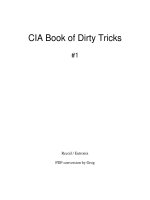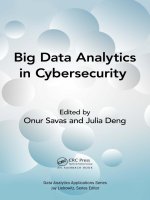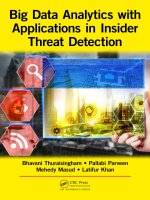Hacking ebook bigdataanalyticswithapplicationsininsiderthreatdetection
Bạn đang xem bản rút gọn của tài liệu. Xem và tải ngay bản đầy đủ của tài liệu tại đây (15.75 MB, 579 trang )
Big Data Analytics with
Applications in Insider
Threat Detection
Big Data Analytics with
Applications in Insider
Threat Detection
Bhavani Thuraisingham
Mohammad Mehedy Masud
Pallabi Parveen
Latifur Khan
CRC Press
Taylor & Francis Group
6000 Broken Sound Parkway NW, Suite 300
Boca Raton, FL 33487-2742
© 2018 by Taylor & Francis Group, LLC
CRC Press is an imprint of Taylor & Francis Group, an Informa business
No claim to original U.S. Government works
Printed on acid-free paper
International Standard Book Number-13: 978-1-4987-0547-9 (Hardback)
This book contains information obtained from authentic and highly regarded sources. Reasonable efforts have been
made to publish reliable data and information, but the author and publisher cannot assume responsibility for the
validity of all materials or the consequences of their use. The authors and publishers have attempted to trace the
copyright holders of all material reproduced in this publication and apologize to copyright holders if permission to
publish in this form has not been obtained. If any copyright material has not been acknowledged please write and let
us know so we may rectify in any future reprint.
Except as permitted under U.S. Copyright Law, no part of this book may be reprinted, reproduced, transmitted, or
utilized in any form by any electronic, mechanical, or other means, now known or hereafter invented, including photocopying, microfilming, and recording, or in any information storage or retrieval system, without written permission
from the publishers.
For permission to photocopy or use material electronically from this work, please access www.copyright.com (http://
www.copyright.com/) or contact the Copyright Clearance Center, Inc. (CCC), 222 Rosewood Drive, Danvers, MA
01923, 978-750-8400. CCC is a not-for-profit organization that provides licenses and registration for a variety of users.
For organizations that have been granted a photocopy license by the CCC, a separate system of payment has been
arranged.
Trademark Notice: Product or corporate names may be trademarks or registered trademarks, and are used only for
identification and explanation without intent to infringe.
Library of Congress Cataloging-in-Publication Data
Names: Parveen, Pallabi, author.
Title: Big data analytics with applications in insider threat detection /
Pallabi Parveen, Bhavani Thuraisingham, Mohammad Mehedy Masud, Latifur Khan.
Description: Boca Raton : Taylor & Francis, CRC Press, 2017. | Includes bibliographical references.
Identifiers: LCCN 2017037808 | ISBN 9781498705479 (hb : alk. paper)
Subjects: LCSH: Computer security--Data processing. | Malware (Computer software) | Big data. |
Computer crimes--Investigation. | Computer networks--Access control.
Classification: LCC QA76.9.A25 P384 2017 | DDC 005.8--dc23
LC record available at />Visit the Taylor & Francis Web site at
and the CRC Press Web site at
We dedicate this book to
Professor Elisa Bertino
Purdue University
Professor Hsinchun Chen
University of Arizona
Professor Jiawei Han
University of Illinois at Urbana-Champaign
And All Others
For Collaborating and Supporting Our Work in
Cyber Security, Security Informatics, and
Stream Data Analytics
Contents
Preface.......................................................................................................................................... xxiii
Acknowledgments.........................................................................................................................xxvii
Permissions....................................................................................................................................xxix
Authors........................................................................................................................................ xxxiii
Chapter 1 Introduction...................................................................................................................1
1.1Overview............................................................................................................1
1.2 Supporting Technologies.................................................................................... 2
1.3 Stream Data Analytics........................................................................................ 3
1.4 Applications of Stream Data Analytics for Insider Threat Detection................ 3
1.5 Experimental BDMA and BDSP Systems......................................................... 4
1.6 Next Steps in BDMA and BDSP........................................................................4
1.7 Organization of This Book................................................................................. 5
1.8 Next Steps........................................................................................................... 9
Part I Supporting Technologies for BDMA and BDSP
Introduction to Part I................................................................................................... 13
Chapter 2 Data Security and Privacy........................................................................................... 15
2.1Overview.......................................................................................................... 15
2.2 Security Policies............................................................................................... 16
2.2.1 Access Control Policies....................................................................... 16
2.2.1.1 Authorization-Based Access Control Policies..................... 16
2.2.1.2 Role-Based Access Control................................................. 18
2.2.1.3 Usage Control...................................................................... 19
2.2.1.4 Attribute-Based Access Control.......................................... 19
2.2.2 Administration Policies.......................................................................20
2.2.3 Identification and Authentication........................................................20
2.2.4 Auditing: A Database System............................................................. 21
2.2.5 Views for Security............................................................................... 21
2.3 Policy Enforcement and Related Issues............................................................ 21
2.3.1 SQL Extensions for Security............................................................... 22
2.3.2 Query Modification............................................................................. 23
2.3.3 Discretionary Security and Database Functions................................. 23
2.4 Data Privacy.....................................................................................................24
2.5 Summary and Directions..................................................................................25
References...................................................................................................................26
Chapter 3 Data Mining Techniques............................................................................................. 27
3.1Introduction...................................................................................................... 27
3.2 Overview of Data Mining Tasks and Techniques............................................ 27
3.3 Artificial Neural Networks...............................................................................28
3.4 Support Vector Machines................................................................................. 31
vii
viii
Contents
3.5
3.6
3.7
3.8
Markov Model.................................................................................................. 32
Association Rule Mining (ARM)..................................................................... 35
Multiclass Problem........................................................................................... 37
Image Mining................................................................................................... 38
3.8.1Overview............................................................................................. 38
3.8.2 Feature Selection................................................................................. 39
3.8.3 Automatic Image Annotation.............................................................. 39
3.8.4 Image Classification............................................................................40
3.9Summary..........................................................................................................40
References...................................................................................................................40
Chapter 4 Data Mining for Security Applications....................................................................... 43
4.1Overview.......................................................................................................... 43
4.2 Data Mining for Cyber Security....................................................................... 43
4.2.1 Cyber Security Threats....................................................................... 43
4.2.1.1 Cyber Terrorism, Insider Threats, and External Attacks.......43
4.2.1.2 Malicious Intrusions............................................................ 45
4.2.1.3 Credit Card Fraud and Identity Theft.................................. 45
4.2.1.4 Attacks on Critical Infrastructures...................................... 45
4.2.2 Data Mining for Cyber Security.........................................................46
4.3 Data Mining Tools............................................................................................ 47
4.4 Summary and Directions.................................................................................. 48
References................................................................................................................... 48
Chapter 5 Cloud Computing and Semantic Web Technologies................................................... 51
5.1Introduction...................................................................................................... 51
5.2 Cloud Computing............................................................................................. 51
5.2.1Overview............................................................................................. 51
5.2.2Preliminaries....................................................................................... 52
5.2.2.1 Cloud Deployment Models.................................................. 53
5.2.2.2 Service Models.................................................................... 53
5.2.3Virtualization...................................................................................... 53
5.2.4 Cloud Storage and Data Management................................................. 54
5.2.5 Cloud Computing Tools...................................................................... 56
5.2.5.1 Apache Hadoop................................................................... 56
5.2.5.2MapReduce.......................................................................... 56
5.2.5.3CouchDB............................................................................. 56
5.2.5.4HBase................................................................................... 56
5.2.5.5MongoDB............................................................................ 56
5.2.5.6Hive...................................................................................... 56
5.2.5.7 Apache Cassandra............................................................... 57
5.3 Semantic Web................................................................................................... 57
5.3.1XML.................................................................................................... 58
5.3.2RDF..................................................................................................... 58
5.3.3SPARQL.............................................................................................. 58
5.3.4OWL.................................................................................................... 59
5.3.5 Description Logics.............................................................................. 59
5.3.6Inferencing..........................................................................................60
5.3.7SWRL.................................................................................................. 61
ix
Contents
5.4
Semantic Web and Security.............................................................................. 61
5.4.1 XML Security..................................................................................... 62
5.4.2 RDF Security....................................................................................... 62
5.4.3 Security and Ontologies...................................................................... 63
5.4.4 Secure Query and Rules Processing................................................... 63
5.5 Cloud Computing Frameworks Based on Semantic Web Technologies.......... 63
5.5.1 RDF Integration.................................................................................. 63
5.5.2 Provenance Integration........................................................................64
5.6 Summary and Directions.................................................................................. 65
References................................................................................................................... 65
Chapter 6 Data Mining and Insider Threat Detection................................................................. 67
6.1Introduction...................................................................................................... 67
6.2 Insider Threat Detection................................................................................... 67
6.3 The Challenges, Related Work, and Our Approach......................................... 68
6.4 Data Mining for Insider Threat Detection........................................................ 69
6.4.1 Our Solution Architecture................................................................... 69
6.4.2 Feature Extraction and Compact Representation................................ 70
6.4.2.1 Vector Representation of the Content.................................. 70
6.4.2.2 Subspace Clustering............................................................. 71
6.4.3 RDF Repository Architecture............................................................. 72
6.4.4 Data Storage........................................................................................ 73
6.4.4.1 File Organization................................................................. 73
6.4.5 Answering Queries Using Hadoop MapReduce................................. 74
6.4.6 Data Mining Applications................................................................... 74
6.5 Comprehensive Framework.............................................................................. 75
6.6 Summary and Directions.................................................................................. 76
References................................................................................................................... 77
Chapter 7 Big Data Management and Analytics Technologies................................................... 79
7.1Introduction...................................................................................................... 79
7.2 Infrastructure Tools to Host BDMA Systems.................................................. 79
7.3 BDMA Systems and Tools............................................................................... 81
7.3.1 Apache Hive........................................................................................ 81
7.3.2 Google BigQuery................................................................................ 81
7.3.3 NoSQL Database................................................................................. 81
7.3.4 Google BigTable.................................................................................. 82
7.3.5 Apache HBase..................................................................................... 82
7.3.6MongoDB............................................................................................ 82
7.3.7 Apache Cassandra............................................................................... 82
7.3.8 Apache CouchDB................................................................................ 82
7.3.9 Oracle NoSQL Database..................................................................... 82
7.3.10Weka.................................................................................................... 83
7.3.11 Apache Mahout................................................................................... 83
7.4 Cloud Platforms................................................................................................ 83
7.4.1 Amazon Web Services’ DynamoDB................................................... 83
7.4.2 Microsoft Azure’s Cosmos DB........................................................... 83
7.4.3 IBM’s Cloud-Based Big Data Solutions..............................................84
7.4.4 Google’s Cloud-Based Big Data Solutions..........................................84
x
Contents
7.5 Summary and Directions....................................................................................84
References...................................................................................................................84
Conclusion to Part I..................................................................................................... 87
Part II Stream Data Analytics
Introduction to Part II.................................................................................................. 91
Chapter 8 Challenges for Stream Data Classification.................................................................. 93
8.1Introduction...................................................................................................... 93
8.2Challenges........................................................................................................ 93
8.3 Infinite Length and Concept Drift....................................................................94
8.4 Concept Evolution............................................................................................ 95
8.5 Limited Labeled Data....................................................................................... 98
8.6Experiments......................................................................................................99
8.7 Our Contributions........................................................................................... 100
8.8 Summary and Directions................................................................................ 101
References................................................................................................................. 101
Chapter 9 Survey of Stream Data Classification........................................................................ 105
9.1Introduction.................................................................................................... 105
9.2 Approach to Data Stream Classification........................................................ 105
9.3 Single-Model Classification............................................................................ 106
9.4 Ensemble Classification and Baseline Approach........................................... 107
9.5 Novel Class Detection.................................................................................... 108
9.5.1 Novelty Detection.............................................................................. 108
9.5.2 Outlier Detection............................................................................... 108
9.5.3 Baseline Approach............................................................................ 109
9.6 Data Stream Classification with Limited Labeled Data................................. 109
9.6.1 Semisupervised Clustering................................................................ 109
9.6.2 Baseline Approach............................................................................ 110
9.7 Summary and Directions................................................................................ 110
References................................................................................................................. 111
Chapter 10 A Multi-Partition, Multi-Chunk Ensemble for Classifying Concept-Drifting
Data Streams............................................................................................................. 115
10.1Introduction.................................................................................................... 115
10.2 Ensemble Development.................................................................................. 115
10.2.1 Multiple Partitions of Multiple Chunks............................................ 115
10.2.1.1 An Ensemble Built on MPC.............................................. 115
10.2.1.2 MPC Ensemble Updating Algorithm................................ 115
10.2.2 Error Reduction Using MPC Training.............................................. 116
10.2.2.1 Time Complexity of MPC................................................. 121
10.3Experiments.................................................................................................... 121
10.3.1 Datasets and Experimental Setup..................................................... 122
10.3.1.1 Real (Botnet) Dataset......................................................... 122
10.3.1.2 Baseline Methods.............................................................. 122
Contents
xi
10.3.2 Performance Study............................................................................ 122
10.4 Summary and Directions................................................................................ 125
References................................................................................................................. 126
Chapter 11 Classification and Novel Class Detection in Concept-Drifting Data Streams.......... 127
11.1Introduction.................................................................................................... 127
11.2ECSMiner....................................................................................................... 127
11.2.1Overview........................................................................................... 127
11.2.2 High Level Algorithm....................................................................... 128
11.2.3 Nearest Neighborhood Rule.............................................................. 129
11.2.4 Novel Class and Its Properties.......................................................... 130
11.2.5 Base Learners.................................................................................... 131
11.2.6 Creating Decision Boundary during Training.................................. 132
11.3 Classification with Novel Class Detection..................................................... 133
11.3.1 High-Level Algorithm....................................................................... 133
11.3.2Classification..................................................................................... 134
11.3.3 Novel Class Detection....................................................................... 134
11.3.4 Analysis and Discussion.................................................................... 137
11.3.4.1 Justification of the Novel Class Detection Algorithm....... 137
11.3.4.2 Deviation between Approximate and Exact q-NSC
Computation...................................................................... 138
11.3.4.3 Time and Space Complexity.............................................. 140
11.4Experiments.................................................................................................... 141
11.4.1Datasets............................................................................................. 141
11.4.1.1 Synthetic Data with only Concept Drift (SynC)................ 141
11.4.1.2 Synthetic Data with Concept Drift and Novel Class
(SynCN)............................................................................. 141
11.4.1.3 Real Data—KDDCup 99 Network Intrusion Detection
(KDD)................................................................................ 141
11.4.1.4 Real Data—Forest Covers Dataset from UCI
Repository (Forest)............................................................ 142
11.4.2 Experimental Set-Up......................................................................... 142
11.4.3 Baseline Approach............................................................................ 142
11.4.4 Performance Study............................................................................ 143
11.4.4.1 Evaluation Approach......................................................... 143
11.4.4.2Results................................................................................ 143
11.5 Summary and Directions................................................................................ 148
References................................................................................................................. 148
Chapter 12 Data Stream Classification with Limited Labeled Training Data............................. 149
12.1Introduction.................................................................................................... 149
12.2 Description of ReaSC..................................................................................... 149
12.3 Training with Limited Labeled Data.............................................................. 152
12.3.1 Problem Description.......................................................................... 152
12.3.2Unsupervised K-Means Clustering.................................................... 152
12.3.3 K-Means Clustering with Cluster-Impurity Minimization............... 152
12.3.4 Optimizing the Objective Function with Expectation
Maximization (E-M)......................................................................... 154
12.3.5 Storing the Classification Model....................................................... 155
xii
Contents
12.4 Ensemble Classification.................................................................................. 156
12.4.1 Classification Overview.................................................................... 156
12.4.2 Ensemble Refinement........................................................................ 156
12.4.3 Ensemble Update............................................................................... 160
12.4.4 Time Complexity............................................................................... 160
12.5Experiments.................................................................................................... 160
12.5.1Dataset............................................................................................... 160
12.5.2 Experimental Setup........................................................................... 162
12.5.3 Comparison with Baseline Methods................................................. 163
12.5.4 Running Times, Scalability, and Memory Requirement................... 165
12.5.5 Sensitivity to Parameters................................................................... 166
12.6 Summary and Directions................................................................................ 168
References................................................................................................................. 168
Chapter 13 Directions in Data Stream Classification.................................................................. 171
13.1Introduction.................................................................................................... 171
13.2 Discussion of the Approaches........................................................................ 171
13.2.1 MPC Ensemble Approach................................................................. 171
13.2.2 Classification and Novel Class Detection in Data Streams
(ECSMiner)....................................................................................... 172
13.2.3 Classification with Scarcely Labeled Data (ReaSC)......................... 172
13.3Extensions....................................................................................................... 172
13.4 Summary and Directions................................................................................ 175
References................................................................................................................. 175
Conclusion to Part II................................................................................................. 177
Part III Stream Data Analytics for Insider Threat Detection
Introduction to Part III.............................................................................................. 181
Chapter 14 Insider Threat Detection as a Stream Mining Problem............................................ 183
14.1Introduction.................................................................................................... 183
14.2 Sequence Stream Data.................................................................................... 184
14.3 Big Data Issues............................................................................................... 184
14.4Contributions.................................................................................................. 185
14.5 Summary and Directions................................................................................ 186
References................................................................................................................. 186
Chapter 15 Survey of Insider Threat and Stream Mining........................................................... 189
15.1Introduction.................................................................................................... 189
15.2 Insider Threat Detection................................................................................. 189
15.3 Stream Mining................................................................................................ 191
15.4 Big Data Techniques for Scalability............................................................... 192
15.5 Summary and Directions................................................................................ 193
References................................................................................................................. 194
Contents
xiii
Chapter 16 Ensemble-Based Insider Threat Detection................................................................ 197
16.1Introduction.................................................................................................... 197
16.2 Ensemble Learning......................................................................................... 197
16.3 Ensemble for Unsupervised Learning............................................................ 199
16.4 Ensemble for Supervised Learning................................................................200
16.5 Summary and Directions................................................................................ 201
References................................................................................................................. 201
Chapter 17 Details of Learning Classes...................................................................................... 203
17.1Introduction.................................................................................................... 203
17.2 Supervised Learning......................................................................................203
17.3 Unsupervised Learning..................................................................................203
17.3.1GBAD-MDL.....................................................................................204
17.3.2GBAD-P............................................................................................204
17.3.3GBAD-MPS......................................................................................205
17.4 Summary and Directions................................................................................205
References................................................................................................................. 205
Chapter 18 Experiments and Results for Nonsequence Data......................................................207
18.1Introduction....................................................................................................207
18.2Dataset............................................................................................................207
18.3 Experimental Setup........................................................................................209
18.3.1 Supervised Learning.........................................................................209
18.3.2 Unsupervised Learning..................................................................... 210
18.4Results............................................................................................................ 210
18.4.1 Supervised Learning......................................................................... 210
18.4.2 Unsupervised Learning..................................................................... 212
18.5 Summary and Directions................................................................................ 215
References................................................................................................................. 215
Chapter 19 Insider Threat Detection for Sequence Data............................................................. 217
19.1Introduction.................................................................................................... 217
19.2 Classifying Sequence Data............................................................................. 217
19.3 Unsupervised Stream-Based Sequence Learning (USSL)............................. 220
19.3.1 Construct the LZW Dictionary by Selecting the Patterns in the
Data Stream....................................................................................... 221
19.3.2 Constructing the Quantized Dictionary............................................ 222
19.4 Anomaly Detection......................................................................................... 223
19.5 Complexity Analysis......................................................................................224
19.6 Summary and Directions................................................................................224
References................................................................................................................. 225
Chapter 20 Experiments and Results for Sequence Data............................................................ 227
20.1Introduction.................................................................................................... 227
20.2Dataset............................................................................................................ 227
20.3 Concept Drift in the Training Set................................................................... 228
xiv
Contents
20.4Results............................................................................................................ 230
20.4.1 Choice of Ensemble Size................................................................... 233
20.5 Summary and Directions................................................................................ 235
References................................................................................................................. 235
Chapter 21 Scalability Using Big Data Technologies.................................................................. 237
21.1Introduction.................................................................................................... 237
21.2 Hadoop Mapreduce Platform......................................................................... 237
21.3 Scalable LZW and QD Construction Using Mapreduce Job.......................... 238
21.3.1 2MRJ Approach................................................................................ 238
21.3.2 1MRJ Approach................................................................................ 241
21.4 Experimental Setup and Results.....................................................................244
21.4.1 Hadoop Cluster..................................................................................244
21.4.2 Big Dataset for Insider Threat Detection..........................................244
21.4.3 Results for Big Data Set Related to Insider Threat Detection........... 245
21.4.3.1 On OD Dataset................................................................... 245
21.4.3.2 On DBD Dataset................................................................246
21.5 Summary and Directions................................................................................248
References................................................................................................................. 249
Chapter 22 Stream Mining and Big Data for Insider Threat Detection...................................... 251
22.1Introduction.................................................................................................... 251
22.2Discussion....................................................................................................... 251
22.3 Future Work.................................................................................................... 252
22.3.1 Incorporate User Feedback............................................................... 252
22.3.2 Collusion Attack................................................................................ 252
22.3.3 Additional Experiments.................................................................... 252
22.3.4 Anomaly Detection in Social Network and Author Attribution....... 252
22.3.5 Stream Mining as a Big Data Mining Problem................................. 253
22.4 Summary and Directions................................................................................ 253
References................................................................................................................. 254
Conclusion to Part III................................................................................................ 257
Part IV Experimental BDMA and BDSP Systems
Introduction to Part IV.............................................................................................. 261
Chapter 23 Cloud Query Processing System for Big Data Management.................................... 263
23.1Introduction.................................................................................................... 263
23.2 Our Approach.................................................................................................264
23.3 Related Work.................................................................................................. 265
23.4Architecture.................................................................................................... 267
23.5 Mapreduce Framework................................................................................... 269
23.5.1Overview........................................................................................... 269
23.5.2 Input Files Selection.......................................................................... 270
23.5.3 Cost Estimation for Query Processing.............................................. 270
23.5.4 Query Plan Generation...................................................................... 274
Contents
xv
23.5.5 Breaking Ties by Summary Statistics............................................... 277
23.5.6 MapReduce Join Execution............................................................... 278
23.6Results............................................................................................................ 279
23.6.1 Experimental Setup........................................................................... 279
23.6.2Evaluation..........................................................................................280
23.7 Security Extensions........................................................................................ 281
23.7.1 Access Control Model....................................................................... 282
23.7.2 Access Token Assignment................................................................. 283
23.7.3Conflicts............................................................................................284
23.8 Summary and Directions................................................................................ 285
References................................................................................................................. 286
Chapter 24 Big Data Analytics for Multipurpose Social Media Applications............................ 289
24.1Introduction.................................................................................................... 289
24.2 Our Premise....................................................................................................290
24.3 Modules of Inxite........................................................................................... 291
24.3.1Overview........................................................................................... 291
24.3.2 Information Engine........................................................................... 291
24.3.2.1 Entity Extraction................................................................ 292
24.3.2.2 Information Integration..................................................... 293
24.3.3 Person of Interest Analysis................................................................ 293
24.3.3.1 InXite Person of Interest Profile Generation and
Analysis............................................................................. 293
24.3.3.2 InXite POI Threat Analysis............................................... 294
24.3.3.3 InXite Psychosocial Analysis............................................ 296
24.3.3.4 Other features.................................................................... 297
24.3.4 InXite Threat Detection and Prediction............................................ 298
24.3.5 Application of SNOD........................................................................300
24.3.5.1SNOD++...................................................................300
24.3.5.2 Benefits of SNOD++...................................................300
24.3.6 Expert Systems Support....................................................................300
24.3.7 Cloud-Design of Inxite to Handle Big Data...................................... 301
24.3.8Implementation..................................................................................302
24.4 Other Applications.........................................................................................302
24.5 Related Work.................................................................................................. 303
24.6 Summary and Directions................................................................................304
References.................................................................................................................304
Chapter 25 Big Data Management and Cloud for Assured Information Sharing........................307
25.1Introduction....................................................................................................307
25.2 Design Philosophy..........................................................................................308
25.3 System Design................................................................................................309
25.3.1 Design of CAISS...............................................................................309
25.3.2 Design of CAISS++.................................................................. 312
25.3.2.1 Limitations of CAISS........................................................ 312
25.3.3 Formal Policy Analysis..................................................................... 321
25.3.4 Implementation Approach................................................................. 321
25.4 Related Work.................................................................................................. 321
xvi
Contents
25.4.1 Our Related Research........................................................................ 322
25.4.2 Overall Related Research.................................................................. 324
25.4.3 Commercial Developments............................................................... 326
25.5 Extensions for Big Data-Based Social Media Applications........................... 326
25.6 Summary and Directions................................................................................ 327
References................................................................................................................. 327
Chapter 26 Big Data Management for Secure Information Integration...................................... 331
26.1Introduction.................................................................................................... 331
26.2 Integrating Blackbook with Amazon s3......................................................... 331
26.3Experiments.................................................................................................... 336
26.4 Summary and Directions................................................................................ 336
References................................................................................................................. 336
Chapter 27 Big Data Analytics for Malware Detection............................................................... 339
27.1Introduction.................................................................................................... 339
27.2 Malware Detection.........................................................................................340
27.2.1 Malware Detection as a Data Stream Classification Problem...........340
27.2.2 Cloud Computing for Malware Detection......................................... 341
27.2.3 Our Contributions.............................................................................. 341
27.3 Related Work.................................................................................................. 342
27.4 Design and Implementation of the System.....................................................344
27.4.1 Ensemble Construction and Updating...............................................344
27.4.2 Error Reduction Analysis..................................................................344
27.4.3 Empirical Error Reduction and Time Complexity............................ 345
27.4.4 Hadoop/MapReduce Framework...................................................... 345
27.5 Malicious Code Detection.............................................................................. 347
27.5.1Overview........................................................................................... 347
27.5.2 Nondistributed Feature Extraction and Selection............................. 347
27.5.3 Distributed Feature Extraction and Selection................................... 348
27.6Experiments.................................................................................................... 349
27.6.1Datasets............................................................................................. 349
27.6.2 Baseline Methods.............................................................................. 350
27.7Discussion....................................................................................................... 351
27.8 Summary and Directions................................................................................ 352
References................................................................................................................. 353
Chapter 28 A Semantic Web-Based Inference Controller for Provenance Big Data................... 355
28.1Introduction.................................................................................................... 355
28.2 Architecture for the Inference Controller....................................................... 356
28.3 Semantic Web Technologies and Provenance................................................360
28.3.1 Semantic Web-Based Models............................................................360
28.3.2 Graphical Models and Rewriting...................................................... 361
28.4 Inference Control through Query Modification............................................. 361
28.4.1 Our Approach.................................................................................... 361
28.4.2 Domains and Provenance.................................................................. 362
28.4.3 Inference Controller with Two Users................................................ 363
28.4.4 SPARQL Query Modification...........................................................364
xvii
Contents
28.5 Implementing the Inference Controller.......................................................... 365
28.5.1 Our Approach.................................................................................... 365
28.5.2 Implementation of a Medical Domain.............................................. 365
28.5.3 Generating and Populating the Knowledge Base.............................. 366
28.5.4 Background Generator Module......................................................... 366
28.6 Big Data Management and Inference Control................................................ 367
28.7 Summary and Directions................................................................................ 368
References................................................................................................................. 368
Conclusion to Part IV................................................................................................ 373
Part V Next Steps for BDMA and BDSP
Introduction to Part V............................................................................................... 377
Chapter 29 Confidentiality, Privacy, and Trust for Big Data Systems......................................... 379
29.1Introduction.................................................................................................... 379
29.2 Trust, Privacy, and Confidentiality................................................................. 379
29.2.1 Current Successes and Potential Failures......................................... 380
29.2.2 Motivation for a Framework.............................................................. 381
29.3 CPT Framework............................................................................................. 381
29.3.1 The Role of the Server....................................................................... 381
29.3.2 CPT Process...................................................................................... 382
29.3.3 Advanced CPT.................................................................................. 382
29.3.4 Trust, Privacy, and Confidentiality Inference Engines..................... 383
29.4 Our Approach to Confidentiality Management.............................................. 384
29.5 Privacy for Social Media Systems.................................................................. 385
29.6 Trust for Social Networks............................................................................... 387
29.7 Integrated System........................................................................................... 387
29.8 CPT within the Context of Big Data and Social Networks............................ 388
29.9 Summary and Directions................................................................................ 390
References................................................................................................................. 390
Chapter 30 Unified Framework for Secure Big Data Management and Analytics...................... 391
30.1Overview........................................................................................................ 391
30.2 Integrity Management and Data Provenance for Big Data Systems.............. 391
30.2.1 Need for Integrity.............................................................................. 391
30.2.2 Aspects of Integrity........................................................................... 392
30.2.3 Inferencing, Data Quality, and Data Provenance.............................. 393
30.2.4 Integrity Management, Cloud Services and Big Data....................... 394
30.2.5 Integrity for Big Data........................................................................ 396
30.3 Design of Our Framework.............................................................................. 397
30.4 The Global Big Data Security and Privacy Controller...................................400
30.5 Summary and Directions................................................................................ 401
References................................................................................................................. 401
Chapter 31 Big Data, Security, and the Internet of Things.........................................................403
31.1Introduction....................................................................................................403
xviii
Contents
31.2 Use Cases........................................................................................................404
31.3 Layered Framework for Secure IoT................................................................406
31.4 Protecting the Data.........................................................................................407
31.5 Scalable Analytics for IoT Security Applications..........................................408
31.6 Summary and Directions................................................................................ 411
References................................................................................................................. 411
Chapter 32 Big Data Analytics for Malware Detection in Smartphones.................................... 413
32.1Introduction.................................................................................................... 413
32.2 Our Approach................................................................................................. 414
32.2.1Challenges......................................................................................... 414
32.2.2 Behavioral Feature Extraction and Analysis..................................... 415
32.2.2.1 Graph-Based Behavior Analysis....................................... 415
32.2.2.2 Sequence-Based Behavior Analysis.................................. 416
32.2.2.3 Evolving Data Stream Classification................................ 416
32.2.3 Reverse Engineering Methods.......................................................... 417
32.2.4 Risk-Based Framework..................................................................... 417
32.2.5 Application to Smartphones.............................................................. 418
32.2.5.1 Data Gathering.................................................................. 419
32.2.5.2 Malware Detection............................................................ 419
32.2.5.3 Data Reverse Engineering of Smartphone
Applications..................................................................... 419
32.3 Our Experimental Activities.......................................................................... 419
32.3.1 Covert Channel Attack in Mobile Apps............................................ 420
32.3.2 Detecting Location Spoofing in Mobile Apps.................................. 420
32.3.3 Large Scale, Automated Detection of SSL/TLS
Man-in-the-Middle Vulnerabilities in Android Apps....................... 421
32.4 Infrastructure Development............................................................................ 421
32.4.1 Virtual Laboratory Development...................................................... 421
32.4.1.1 Laboratory Setup.............................................................. 421
32.4.1.2 Programming Projects to Support the Virtual Lab.......... 423
32.4.1.3 An Intelligent Fuzzier for the Automatic Android
GUI Application Testing.................................................. 423
32.4.1.4 Problem Statement............................................................ 423
32.4.1.5 Understanding the Interface............................................. 423
32.4.1.6 Generating Input Events................................................... 424
32.4.1.7 Mitigating Data Leakage in Mobile Apps Using a
Transactional Approach................................................... 424
32.4.1.8 Technical Challenges........................................................ 425
32.4.1.9 Experimental System........................................................ 425
32.4.1.10Policy Engine.................................................................... 426
32.4.2 Curriculum Development.................................................................. 426
32.4.2.1 Extensions to Existing Courses........................................ 426
32.4.2.2 New Capstone Course on Secure Mobile Computing...... 428
32.5 Summary and Directions................................................................................ 429
References................................................................................................................. 429
Chapter 33 Toward a Case Study in Healthcare for Big Data Analytics and Security................ 433
33.1Introduction.................................................................................................... 433
Contents
xix
33.2Motivation....................................................................................................... 433
33.2.1 The Problem...................................................................................... 433
33.2.2 Air Quality Data................................................................................ 435
33.2.3 Need for Such a Case Study.............................................................. 435
33.3Methodologies................................................................................................ 436
33.4 The Framework Design.................................................................................. 437
33.4.1 Storing and Retrieving Multiple Types of Scientific Data................ 437
33.4.1.1 The Problem and Challenges............................................. 437
33.4.1.2 Current Systems and Their Limitations............................ 438
33.4.1.3 The Future System............................................................. 439
33.4.2 Privacy and Security Aware Data Management for
Scientific Data...................................................................................440
33.4.2.1 The Problem and Challenges.............................................440
33.4.2.2 Current Systems and Their Limitations............................440
33.4.2.3 The Future System............................................................. 441
33.4.3 Offline Scalable Statistical Analytics............................................... 442
33.4.3.1 The Problem and Challenges............................................. 442
33.4.3.2 Current Systems and Their Limitations............................ 443
33.4.3.3 The Future System.............................................................444
33.4.3.4 Mixed Continuous and Discrete Domains........................444
33.4.4 Real-Time Stream Analytics.............................................................446
33.4.4.1 The Problem and Challenges.............................................446
33.4.5 Current Systems and Their Limitations............................................446
33.4.5.1 The Future System.............................................................446
33.5 Summary and Directions................................................................................448
References.................................................................................................................448
Chapter 34 Toward an Experimental Infrastructure and Education Program for BDMA
and BDSP.................................................................................................................. 453
34.1Introduction.................................................................................................... 453
34.2 Current Research and Infrastructure Activities in BDMA
and BDSP....................................................................................................... 454
34.2.1 Big Data Analytics for Insider Threat Detection.............................. 454
34.2.2 Secure Data Provenance.................................................................... 454
34.2.3 Secure Cloud Computing.................................................................. 454
34.2.4 Binary Code Analysis....................................................................... 455
34.2.5 Cyber-Physical Systems Security...................................................... 455
34.2.6 Trusted Execution Environment........................................................ 455
34.2.7 Infrastructure Development.............................................................. 455
34.3 Education and Infrastructure Program in BDMA.......................................... 455
34.3.1 Curriculum Development.................................................................. 455
34.3.2 Experimental Program...................................................................... 457
34.3.2.1 Geospatial Data Processing on GDELT............................ 458
34.3.2.2 Coding for Political Event Data......................................... 458
34.3.2.3 Timely Health Indicator..................................................... 459
34.4 Security and Privacy for Big Data.................................................................. 459
34.4.1 Our Approach.................................................................................... 459
34.4.2 Curriculum Development..................................................................460
34.4.2.1 Extensions to Existing Courses.........................................460
34.4.2.2 New Capstone Course on BDSP........................................ 461
xx
Contents
34.4.3 Experimental Program...................................................................... 461
34.4.3.1 Laboratory Setup............................................................... 461
34.4.3.2 Programming Projects to Support the Lab........................ 462
34.5 Summary and Directions................................................................................465
References.................................................................................................................465
Chapter 35 Directions for BDSP and BDMA..............................................................................469
35.1Introduction....................................................................................................469
35.2 Issues in BDSP...............................................................................................469
35.2.1Introduction.......................................................................................469
35.2.2 Big Data Management and Analytics................................................ 470
35.2.3 Security and Privacy......................................................................... 471
35.2.4 Big Data Analytics for Security Applications................................... 472
35.2.5 Community Building......................................................................... 472
35.3 Summary of Workshop Presentations............................................................ 472
35.3.1 Keynote Presentations....................................................................... 473
35.3.1.1 Toward Privacy Aware Big Data Analytics...................... 473
35.3.1.2 Formal Methods for Preserving Privacy While
Loading Big Data.............................................................. 473
35.3.1.3 Authenticity of Digital Images in Social Media............... 473
35.3.1.4 Business Intelligence Meets Big Data: An Overview
of Security and Privacy..................................................... 473
35.3.1.5 Toward Risk-Aware Policy-Based Framework for
BDSP............................................................................ 473
35.3.1.6 Big Data Analytics: Privacy Protection Using
Semantic Web Technologies............................................. 473
35.3.1.7 Securing Big Data in the Cloud: Toward a More
Focused and Data-Driven Approach................................. 473
35.3.1.8 Privacy in a World of Mobile Devices.............................. 474
35.3.1.9 Access Control and Privacy Policy Challenges in
Big Data............................................................................ 474
35.3.1.10Timely Health Indicators Using Remote Sensing
and Innovation for the Validity of the Environment......... 474
35.3.1.11Additional Presentations.................................................... 474
35.3.1.12Final Thoughts on the Presentations................................. 474
35.4 Summary of the Workshop Discussions......................................................... 474
35.4.1Introduction....................................................................................... 474
35.4.2 Philosophy for BDSP......................................................................... 475
35.4.3 Examples of Privacy-Enhancing Techniques.................................... 475
35.4.4 Multiobjective Optimization Framework for Data Privacy.............. 476
35.4.5 Research Challenges and Multidisciplinary Approaches................. 477
35.4.6 BDMA for Cyber Security................................................................480
35.5 Summary and Directions................................................................................ 481
References................................................................................................................. 481
Conclusion to Part V................................................................................................. 483
xxi
Contents
Chapter 36 Summary and Directions.......................................................................................... 485
36.1
36.2
36.3
36.4
About This Chapter........................................................................................ 485
Summary of This Book.................................................................................. 485
Directions for BDMA and BDSP................................................................... 490
Where Do We Go from Here?........................................................................ 491
Appendix A: Data Management Systems: Developments and Trends.................................... 493
Appendix B: Database Management Systems............................................................................507
Index............................................................................................................................................... 525
Preface
BACKGROUND
Recent developments in information systems technologies have resulted in computerizing many
applications in various business areas. Data has become a critical resource in many organizations,
and therefore, efficient access to data, sharing the data, extracting information from the data, and
making use of the information has become an urgent need. As a result, there have been many efforts
on not only integrating the various data sources scattered across several sites, but extracting information from these databases in the form of patterns and trends and carrying out data analytics has
also become important. These data sources may be databases managed by database management
systems, or they could be data warehoused in a repository from multiple data sources.
The advent of the World Wide Web in the mid-1990s has resulted in even greater demand for
managing data, information, and knowledge effectively. During this period, the services paradigm
was conceived which has now evolved into providing computing infrastructures, software, databases, and applications as services. Such capabilities have resulted in the notion of cloud computing.
Over the past 5 years, developments in cloud computing have exploded and we now have several
companies providing infrastructure software and application computing platforms as services.
As the demand for data and information management increases, there is also a critical need for
maintaining the security of the databases, applications, and information systems. Data, information, applications, the web, and the cloud have to be protected from unauthorized access as well as
from malicious corruption. The approaches to secure such systems have come to be known as cyber
security.
The significant developments in data management and analytics, web services, cloud computing,
and cyber security have evolved into an area called big data management and analytics (BDMA)
as well as big data security and privacy (BDSP). The U.S. Bureau of Labor and Statistics defines
big data as a collection of large datasets that cannot be analyzed with normal statistical methods.
The datasets can represent numerical, textual, and multimedia data. Big data is popularly defined
in terms of five Vs: volume, velocity, variety, veracity, and value. BDMA requires handling huge
volumes of data, both structured and unstructured, arriving at high velocity. By harnessing big data,
we can achieve breakthroughs in several key areas such as cyber security and healthcare, resulting
in increased productivity and profitability. Not only do the big data systems have to be secure, the
big data analytics have to be applied for cyber security applications such as insider threat detection.
This book will review the developments in topics both BDMA and BDSP and discuss the issues
and challenges in securing big data as well as applying big data techniques to solve problems. We
will focus on a specific big data analytics technique called stream data mining as well as approaches
to applying this technique to insider threat detection. We will also discuss several experimental
systems, infrastructures and education programs we have developed at The University of Texas at
Dallas on both BDMA and BDSP.
We have written two series of books for CRC Press on data management/data mining and data
security. The first series consist of 10 books. Book #1 (Data Management Systems Evolution and
Interoperation) focused on general aspects of data management and also addressed interoperability
and migration. Book #2 (Data Mining: Technologies, Techniques, Tools, and Trends) discussed
data mining. It essentially elaborated on Chapter 9 of Book #1. Book #3 (Web Data Management
and Electronic Commerce) discussed web database technologies and discussed e-commerce as
an application area. It essentially elaborated on Chapter 10 of Book #1. Book #4 (Managing and
Mining Multimedia Databases) addressed both multimedia database management and multimedia
data mining. It elaborated on both Chapter 6 of Book #1 (for multimedia database management)
xxiii
xxiv
Preface
and Chapter 11 of Book #2 (for multimedia data mining). Book #5 (XML, Databases and the
Semantic Web) described XML technologies related to data management. It elaborated on Chapter
11 of Book #3. Book #6 (Web Data Mining and Applications in Business Intelligence and Counterterrorism) elaborated on Chapter 9 of Book #3. Book #7 (Database and Applications Security)
examined security for technologies discussed in each of our previous books. It focuses on the technological developments in database and applications security. It is essentially the integration of
Information Security and Database Technologies. Book #8 (Building Trustworthy Semantic Webs)
applies security to semantic web technologies and elaborates on Chapter 25 of Book #7. Book #9
(Secure Semantic Service-Oriented Systems) is an elaboration of Chapter 16 of Book #8. Book #10
(Developing and Securing the Cloud) is an elaboration of Chapters 5 and 25 of Book #9.
Our second series of books at present consists of four books. Book #1 is Design and
Implementation of Data Mining Tools. Book #2 is Data Mining Tools for Malware Detection. Book
#3 is Secure Data Provenance and Inference Control with Semantic Web. Book #4 is Analyzing
and Securing Social Networks. Book #5, which is the current book, is Big Data Analytics with
Applications in Insider Threat Detection. For this series, we are converting some of the practical
aspects of our work with students into books. The relationships between our texts will be illustrated in Appendix A.
ORGANIZATION OF THIS BOOK
This book is divided into five parts, each describing some aspect of the technology that is relevant
to BDMA and BSDP. The major focus of this book will be on stream data analytics and its applications in insider threat detection. In addition, we will also discuss some of the experimental systems
we have developed and provide some of the challenges involved.
Part I, consisting of six chapters, will describe supporting technologies for BDMA and BDSP
including data security and privacy, data mining, cloud computing and semantic web. Part II,
consisting of six chapters, provides a detailed overview of the techniques we have developed for
stream data analytics. In particular, we will describe our techniques on novel class detection for
data streams. Part III, consisting of nine chapters, will discuss the applications of stream analytics
for insider threat detection. Part IV, consisting of six chapters, will discuss some of the experimental
systems we have developed based on BDMA and BDSP. These include secure query processing for
big data as well as social media analysis. Part V, consisting of seven chapters, discusses some of the
challenges for BDMA and BDSP. In particular, securing the Internet of Things as well as our plans
for developing experimental infrastructures for BDMA and BDSP are also discussed.
DATA, INFORMATION, AND KNOWLEDGE
In general, data management includes managing the databases, interoperability, migration, warehousing, and mining. For example, the data on the web has to be managed and mined to extract
information and patterns and trends. Data could be in files, relational databases, or other types of
databases such as multimedia databases. Data may be structured or unstructured. We repeatedly
use the terms data, data management, and database systems and database management systems in
this book. We elaborate on these terms in the appendix. We define data management systems to be
systems that manage the data, extract meaningful information from the data, and make use of the
information extracted. Therefore, data management systems include database systems, data warehouses, and data mining systems. Data could be structured data such as those found in relational
databases, or it could be unstructured such as text, voice, imagery, and video.
There have been numerous discussions in the past to distinguish between data, information, and
knowledge. In some of our previous books on data management and mining, we did not attempt to
clarify these terms. We simply stated that, data could be just bits and bytes or it could convey some
meaningful information to the user. However, with the web and also with increasing interest in data,









